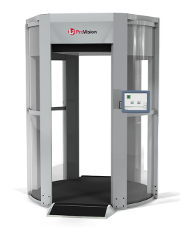































HAS THE SAFETY ISSUE BEEN RESOLVED?
|When the TSA announced earlier last year that the naked body machines were being removed from the busiest airports in Chicago, Los Angeles, New York and Boston to speed up security screening, most people were relieved. However, these machines were still being used at other airports around the country.
 Then, towards the end of 2012 it was announced that all of these machines would be replaced, because the manufacturer was not able to provide a generic image on the screen as mandated and could only continue to show a very revealing personal picture that outraged travelers who considered it a visual strip search.
Then, towards the end of 2012 it was announced that all of these machines would be replaced, because the manufacturer was not able to provide a generic image on the screen as mandated and could only continue to show a very revealing personal picture that outraged travelers who considered it a visual strip search.
All of the naked image machines are due to be removed from all airports by June 1, 2013 and warehoused until they can be modified for other use. Although this is excellent news from a privacy standpoint, the second main issue with the backscatter machines is that they expose people to dangerous radiation on their skin and soft tissue.
The TSA claimed the machines were not harmful, as the levels of radiation exposure were very low. However, medical personnel with knowledge of the health issues involved from cumulative amounts of radiation exposure communicated their concerns to the government. Pilots and crew members objected to this work hazard and were exempted from passing through the backscatter machines. Widespread testing was never done to determine how damaging the effects were to passengers.
 Happily, the backscatter machines have been banished and are being replaced with millimeter wave imaging technology which could be adapted to show only generic body images. Again, the focus is on the privacy guidelines rather than any safety issues.
Happily, the backscatter machines have been banished and are being replaced with millimeter wave imaging technology which could be adapted to show only generic body images. Again, the focus is on the privacy guidelines rather than any safety issues.
The wave imaging technology does not have the same radiation risk and, according to the TSA web site, “uses harmless electromagnetic waves to detect potential threats” on a person’s body. Although the new machines offer a safer option, it is not clear whether they are risk-free since extensive testing has not been required before using them.
You will recognize the cylindrical machines, which you must step into before they take a three dimensional picture of your body shape with any anomalies flagged for further inspection. There are no hidden images sent to a separate office for review, and the machine’s results are visible to anyone looking at the screen. If nothing unusual is detected, you step out of the machine and reclaim your carry on items.
I never went through the backscatter machines, because I was concerned for my health, as well as being incensed by a naked image of my body being flashed onto a screen, even one out of the public view. I always requested a private patdown, which was also demeaning. The irony was never lost on me that having been cleared for Pre-Check domestically (only metal detectors) and the Global Entry international safe traveler program to return to the country (TSA operated), I would still have to go through the backscatter machine or a patdown to board an international flight. Fortunately, we have not found any of these machines outside the country. Maybe, a safety issue?
The question now is whether to accept the TSA’s assurances that their new machines are completely safe or continue to bypass them and take a patdown until independent testing confirms that they do not pose any health problems.
What will you do? Does a frequent flyer need to be careful about what machines are used in security screening?
*Pictures were provided from the TSA web site.

 "Flying high over the peaks of Alaska in our 6 passenger plane to Punchbowl Glacier was thrilling. Once on the ground, we boarded our dog sled for an exciting race across the glacier pulled by our team of eager, trained dogs – thinking the Iditarod! And who didn’t love playing with the 3 little future Iditarod puppies afterwards?! It was a wonderful way to enjoy Alaska on our cruise, and we all loved it. Thanks again for a wonderful vacation that was perfect for all ages in our family group." Ann & Steve
"Flying high over the peaks of Alaska in our 6 passenger plane to Punchbowl Glacier was thrilling. Once on the ground, we boarded our dog sled for an exciting race across the glacier pulled by our team of eager, trained dogs – thinking the Iditarod! And who didn’t love playing with the 3 little future Iditarod puppies afterwards?! It was a wonderful way to enjoy Alaska on our cruise, and we all loved it. Thanks again for a wonderful vacation that was perfect for all ages in our family group." Ann & Steve